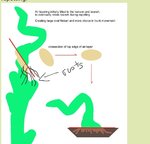Rivka
Shohin
I know that many things with trees will behave quite differently if things are not parallel to the horizon. Upper facing shoots tend to get more energy from the tree, moistures pools on lower sides, leaves reach for sunlight, etc.
So in one way we need to keep many things level or risk the outcome being really lopsided, on the other hand, we can also use these phenomena to our advantage, tilting plants to direct growth.
So my question is if there is an issue with air layering on a slant? Can the bark removal be done in a non-perpendicular manner so that the final tree once cut off from its old trunk can be repotted at a tilt to align the new horizon? Also, this would have the effect of creating a wider oval nebari from an otherwise round trunk?
I have two scenarios I would love feedback on.
Scenario 1.
Horizontal to the ground, but at a slant (not perpendicular) to the branch. This would create a large oval cross-section and hopefully future nebari and keep the natural angle that the branch had been growing.

Scenario 2.
Slanted to both the horizon and the tree branch, giving you both an elongated Nebari and freedom to reorient the branch, as you rotate the cut back to horizontal during repotting.

I can see more advanced use scenarios for this when laying up thick trucks to be planed on steeply slanted surfaces as well.
So basically I wanted to check-in with those possessing experience that I completely lack.
Is this done? does it work? has it been shown not to work? If it does not work, can you explain the science surrounding the failure? is the results species-specific?
I completely understand the science as to why air layering works in general and in many ways #1 seems like a merger of air layering and the ground layering that happens as we make a "raft"
thanks for entertaining my "question everything" nature
-rivka
So in one way we need to keep many things level or risk the outcome being really lopsided, on the other hand, we can also use these phenomena to our advantage, tilting plants to direct growth.
So my question is if there is an issue with air layering on a slant? Can the bark removal be done in a non-perpendicular manner so that the final tree once cut off from its old trunk can be repotted at a tilt to align the new horizon? Also, this would have the effect of creating a wider oval nebari from an otherwise round trunk?
I have two scenarios I would love feedback on.
Scenario 1.
Horizontal to the ground, but at a slant (not perpendicular) to the branch. This would create a large oval cross-section and hopefully future nebari and keep the natural angle that the branch had been growing.

Scenario 2.
Slanted to both the horizon and the tree branch, giving you both an elongated Nebari and freedom to reorient the branch, as you rotate the cut back to horizontal during repotting.

I can see more advanced use scenarios for this when laying up thick trucks to be planed on steeply slanted surfaces as well.
So basically I wanted to check-in with those possessing experience that I completely lack.
Is this done? does it work? has it been shown not to work? If it does not work, can you explain the science surrounding the failure? is the results species-specific?
I completely understand the science as to why air layering works in general and in many ways #1 seems like a merger of air layering and the ground layering that happens as we make a "raft"
thanks for entertaining my "question everything" nature
-rivka


